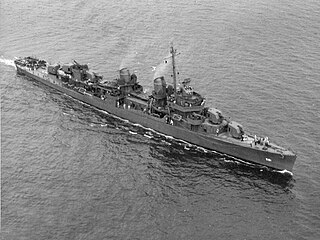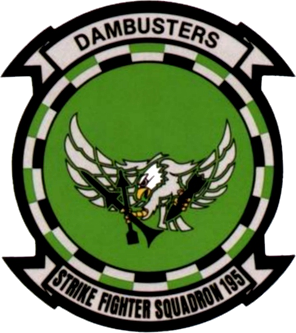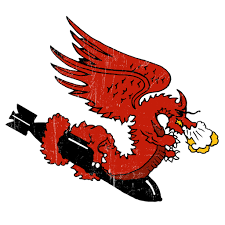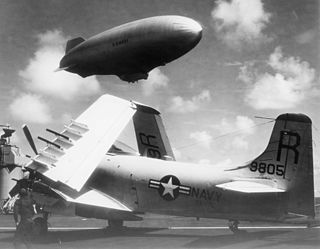
The Battle of Leyte Gulf was the largest naval battle of World War II and by some criteria the largest naval battle in history, with over 200,000 naval personnel involved. It was fought in waters near the Philippine islands of Leyte, Samar, and Luzon from 23 to 26 October 1944 between combined American and Australian forces and the Imperial Japanese Navy (IJN), as part of the invasion of Leyte, which aimed to isolate Japan from the colonies that it had occupied in Southeast Asia, a vital source of industrial and oil supplies.

USS San Jacinto (CVL-30) of the United States Navy was an Independence-class light aircraft carrier that served during World War II. She was named for the Battle of San Jacinto during the Texas Revolution. Former U.S. President George H. W. Bush served aboard the ship during World War II.

The Grumman TBF Avenger is an American World War II-era torpedo bomber developed initially for the United States Navy and Marine Corps, and eventually used by several air and naval aviation services around the world.

USS Makin Island (CVE-93) was a Casablanca-class escort carrier of the United States Navy. It was named for the 1942 Makin raid, an early diversionary raid designed to distract from the Guadalcanal campaign and the Tulagi campaign. Launched in April 1944, and commissioned in May, she served in support of the Philippines campaign, the Invasion of Iwo Jima, and the Battle of Okinawa. Postwar, she participated in Operation Magic Carpet. She was decommissioned in April 1946, and ultimately sold for scrapping in January 1947.

USS Marcus Island (CVE-77) was the twenty-third of fifty Casablanca-class escort carriers built for the United States Navy during World War II. She was named after an engagement on 31 August 1943 over Minami-Tori-shima, known on American maps as Marcus Island. She was launched in December 1943, commissioned in January 1944, and she served in the Mariana and Palau Islands campaign, the Philippines campaign, as well as the Battle of Okinawa. She spent the majority of her World War II as a flagship for various escort carrier formations, serving as the headquarters for Rear Admiral William D. Sample and Felix Stump. During the Philippines campaign, she participated in the Battle off Samar, the largest naval engagement in history, and during the Battle of Mindoro, she had multiple near-brushes with Japanese kamikazes. Post-war, she participated in Operation Magic Carpet, repatriating U.S. servicemen from throughout the Pacific. She was decommissioned in December 1946, being mothballed in the Atlantic Reserve Fleet. Ultimately, she was broken up in 1960.

USS Petrof Bay (CVE-80) was the twenty-sixth of fifty Casablanca-class escort carriers built for the United States Navy during World War II. She was named after Petrof Bay, which in turn was named in 1928 after Ivan Petroff, a Russian Alaskan who served as a special census agent for the 1880 United States census. The bay is located within Kuiu Island, which at the time was a part of the Territory of Alaska. The ship was launched in January 1944, commissioned in February, and served in support of the Mariana and Palau Islands campaign, the Philippines campaign, including the Battle off Samar, the Battle of Iwo Jima, and the Battle of Okinawa. She was decommissioned in July 1946, when she was mothballed in the Atlantic Reserve Fleet. Postwar, she participated in Operation Magic Carpet. Ultimately, she was broken up in September 1959.

USS Charrette (DD-581) was a Fletcher-class destroyer of the United States Navy, named for Lieutenant George Charrette (1867–1938), who was awarded the Medal of Honor for heroism during the Spanish–American War. Entering service during World War II, she spent her career in the Pacific theatre. Placed in reserve following the war, Charette was transferred to the Kingdom of Greece in 1959 and renamed Velos (D16), remaining in service till 1991 before being preserved as a museum ship at Palaio Faliro, Athens.

Strike Fighter Squadron 115 (VFA-115) is known as the "Eagles", callsign "Talon", a United States Navy F/A-18E Super Hornet strike fighter squadron stationed at Marine Corps Air Station Iwakuni. Their tail code is NF. It was established as Torpedo Squadron VT-11 on 10 October 1942, redesignated VA-12A on 15 November 1946, VA-115 on 15 July 1948, then finally VFA-115.

Strike Fighter Squadron 195 (VFA-195), also known as the "Dambusters", is a United States Navy F/A-18E Super Hornet fighter squadron stationed at Marine Corps Air Station Iwakuni, Japan. They are a part of Carrier Air Wing Five (CVW-5) and their tail code is NF. Their radio callsign is "Chippy".

Attack Squadron 75 (VA-75) or ATKRON 75 was an attack squadron of the United States Navy that was active from World War II through the 1990s. Nicknamed the "Sunday Punchers," they were based out of Naval Air Station Oceana, Virginia. Originally established as Bombing Squadron EIGHTEEN (VB-18) on July 20, 1943, it was redesignated Attack Squadron VA-7A on 15 November 1946, redesignated Attack Squadron VA-74 on 27 July 1948, redesignated Attack Squadron VA-75 on 15 February 1950 and disestablished on February 28, 1997. They were the second squadron to be designated VA-75, the first VA-75 was disestablished on 30 November 1949. They were the first fleet squadron to operate the A-6 Intruder and the last unit to fly it in operational service.

Attack Squadron 35 (VA-35) was an aviation unit of the United States Navy. The squadron's nickname is unknown. Its insignia, a winged dragon, was revised several times during its lifetime. The squadron was first established as Torpedo and Bombing Squadron 2 (VT-2) on 6 July 1925, and was redesignated as VT-2B on 1 July 1927, VT-3 on 1 July 1937, VA-4A on 15 November 1946, and, finally, VA-35 on 7 August 1948. The squadron was disestablished on 7 November 1949. It was the first squadron to carry the VA-35 designation, the second VA-35 was redesignated from VA-34 on 15 February 1950 and disestablished on 31 January 1995.

VA-55 was an Attack Squadron of the U.S. Navy. It was established as Torpedo Squadron VT-5 on 15 February 1943, redesignated VA-6A on 15 November 1946, and finally designated VA-55 on 16 August 1948. The squadron was disestablished on 12 December 1975. It was the first squadron to be designated VA-55, the second VA-55 was established on 7 October 1983 and disestablished on 1 January 1991.
VA-75, nicknamed the Carrier Clowns, was an Attack Squadron of the U.S. Navy. It was established as Torpedo Squadron VT-18 on 20 July 1943. The squadron was redesignated as VA-8A on 15 November 1946, and finally as VA-75 on 27 July 1948. It was disestablished on 30 November 1949. A second squadron also bore the VA-75 designation.

VA-94 was an Attack Squadron of the U.S. Navy. It was established as Bombing Squadron VB-99 on 1 July 1943, redesignated as VB-20 on 15 October 1943, and as VA-9A on 15 November 1946. It was finally redesignated as VA-94 on 12 August 1948. The squadron was disestablished on 30 November 1949. Its nickname was Bombing Twenty's Tough Kitty from 1943 to 1946.

VA-114 was an Attack Squadron of the U.S. Navy. It was established as Bombing Squadron VB-11 on 10 October 1942, redesignated VA-11A on 15 November 1946, and finally as VA-114 on 15 July 1948. The squadron was disestablished on 1 December 1949. The squadron was known as the Pegasus.

VA-135 was an Attack Squadron of the U.S. Navy, nicknamed Uninvited. It was established as Torpedo Squadron VT-81 on 1 March 1944, redesignated VA-14A on 15 November 1946, and finally designated VA-135 on 2 August 1948. The squadron was disestablished on 30 November 1949. A second squadron bore the VA-135 designation in 1961-1962; the squadrons were not related.

VA-175, nicknamed the Devil's Diplomats, was an attack squadron of the U.S. Navy. It was established as Torpedo Squadron VT-82 on 1 April 1944, redesignated as VA-18A on 15 November 1946, and as VA-175 on 11 August 1948. The squadron was disestablished on 15 March 1958.
VA-194 was an Attack Squadron of the U.S. Navy. It was established as Bombing Squadron VB-19 on 15 August 1943. It was redesignated as VA-19A on 15 November 1946, and as VA-194 on 24 August 1948. The squadron was disestablished on 1 December 1949. Its nickname is unknown.

VA-34, nicknamed the Blue Blasters, was an Attack Squadron of the U.S. Navy. The squadron was established as Fighter Squadron VF-20 on 15 October 1943, redesignated as VF-9A on 15 November 1946, as VF-91 on 12 August 1948, and as VF-34 on 15 February 1950. It was finally redesignated VA-34 on 1 July 1955. The squadron was disestablished on 1 June 1969. It was the second squadron to bear the VA-34 designation, the first one having been renamed VA-35 in 1950.

Attack Squadron 15 (VA-15), nicknamed the Valions, was an aviation unit of the United States Navy. It was established as Torpedo Squadron 4 (VT-4) on 10 January 1942, redesignated VA-2A on 15 November 1946, and finally redesignated VA-15 on 2 August 1948. The squadron was disestablished on 1 June 1969, after 27 years of service.



















